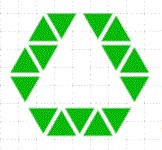IN THIS article, I am going to look at a corrugator wet end machines and their use. As many individual machines make up the complete ready-to-run. The corrugator wet end machines are the start of the process in corrugated cardboard manufacture.
Mill Roll Stands
First, the minimum number of double Mill Roll Stands for mounting paper reels into the corrugator as required for two-ply cardboard is two sets of Mill Roll Stands.
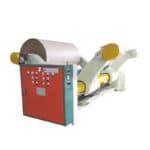
Although this type of corrugated product is in demand. But to be profitable you need to run exceptionally long order lengths and on a wide machine at the fastest possible speed.
This is not always the case because if you experience paper gsm, (grams per square metre) or caliper variation in your raw materials it can become problematic when running at higher speeds.
So, if you move to a 3-ply product this will run much faster and consistently maintain higher running speeds over exceedingly long production runs, you are on to a winner…! With this type of product, you can also make order changes at higher speeds because the product is that much stiffer and easier to handle in automated machines.
To achieve this arrangement, you will need a third Mill Roll Stand. On larger corrugating machines, you can have up to 7 ply’s running together which make up “Triple Wall cardboard”.
Auto Splicer
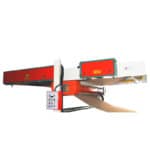
To run a corrugator or multi-ply solid board laminator efficiently, you need an Auto Splicer installed over each Mill Roll Stand. With an Auto, Splicer fitted means that your corrugator or laminator will not need to stop to add in a new paper reel when the first one is used up.
Here is the first big economic advantage you gain with a continuous running high volume production line capability. Most modern auto Splicers are well capable of splicing 100 gsm paper at speeds of over 100 metres per minute.
Bridge Conveyor
Next, we need a means of transporting these separate plies of paper to the fluting and glue machines.
This is a framework with many small rollers that carry and guide the plies to the next process.
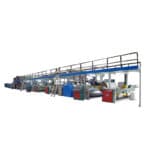
This unit or structure is called a Bridge Conveyor and it may also carry other small machine units, like Edge Guidance alignment units for each ply.
And vacuum brake units to put & hold a small tension into the individual plies as required before reaching the glue and fluting machines.
Pre-Heaters
Now we are at the pre-heaters or board conditioning units. Which are large cylinder rollers that are heated by steam? When the paper passes over these units the paper becomes more manageable to work with and easier to glue the tips of the fluted paper.
The amount of heat required for this job is controlled and monitored by an automatic process in all newer machines.
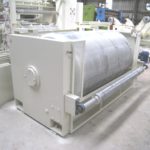
If the paper needs heat, small rollers will guide the paper around the large hot cylinder roller. So, the paper is wrapped around this cylinder for a greater or shorter length of time as the automatic process requires or demands from the system.
It is usual to have one of these pre-heater cylinder rollers per ply.
Single Facer
We have the fluting machines, which are called a Single Facer, whereby the flutes are made in the paper by a complex set of grooved rollers. These rollers are also steam heated to very exact temperatures to run the fluting process followed by the gluing process.
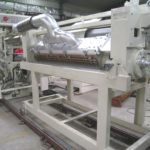
With assorted sizes of fluting required for different orders, these machines have modules called a Cassette. Whereby the flute rollers are already set up in a module and ready to make a quick change over.
Operators can complete this task in less than 15 minutes. This is one of the jobs that the Corrugator has got to stop production for the changeover. Although this is often carried out when order changes occur.
With the next order up, it may not require this unit in the production process as when going from tri-wall down to double-wall corrugated cardboard. In this situation, the corrugator will not need to stop as the web can be cut out easily.
On some modern corrugators when this unit is not in production the changeover of the Cassette can be done and made ready for the next time this Single Facer is required in the production process.
Glue Machine
The glue machines that are used for multi-wall corrugated products make use of a multi-head glue machine.
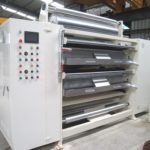
These units usually run at a slightly slower speed than the production line speed. This situation helps to control the tension in the paper materials. It also tends to give a better quality and a more stable product when running at higher speeds. The glue levels in the trays are controlled and monitored very accurately.
These controls come with the machine and accommodate for varying speed in real-time production line operations.
Any changes in glue applications and quality can also be taken care of for any production order requirements.
Heat Chest
We have now reached the end of the Bridge Conveyor on most traditionally corrugators. Here the corrugated sheet passes into the final drying section of the corrugator, here in this unit the last drying operations occur.
It is very important that this part of the process is set up correctly and carried out by experienced operators. Once set the automatic systems will hold the correct temperatures for the production run and accommodate for any changes in speed as they occur.
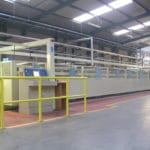
This section of the corrugating production line is called the Double Backer or Heat Chest. Its main job is to produce a firm dry corrugated cardboard product that will meet the design parameters of the running order when it exits this unit.
In this unit, heat is applied to both sides of the cardboard sandwich so that the glue is fully cured at the end of the heat chest conveyor. The control of this part of the production line is monitored closely.
So that under varying production line speeds the steam flow is adjusted and corrected. So that optimum conditions always exists to produce quality corrugated cardboard continually.
This is a key unit to the overall quality of the product produced. There are many operational items within the Heat Chest unit, which must function correctly. This must be achieved for the final product to always maintain superior quality. While the corrugator may need to run at various speeds to accommodate other problems that can occur throughout the run.
